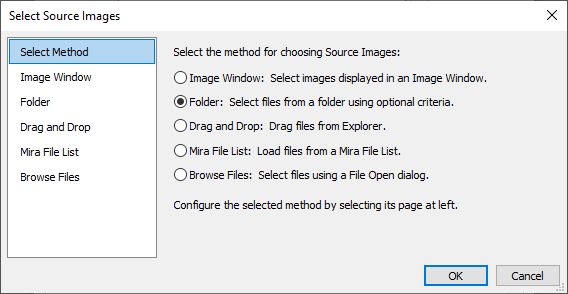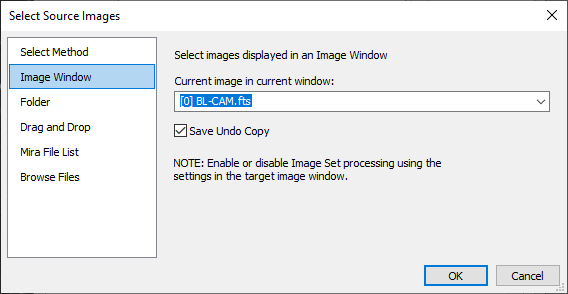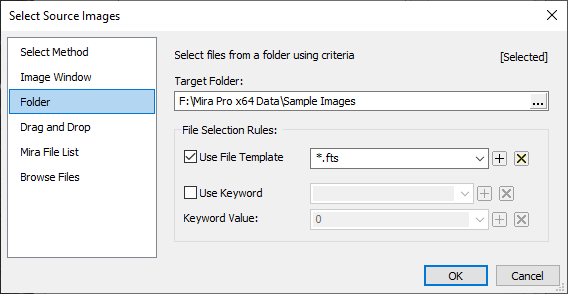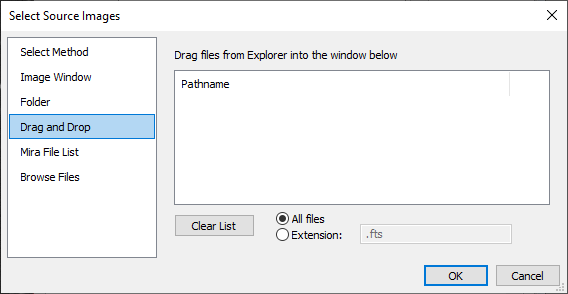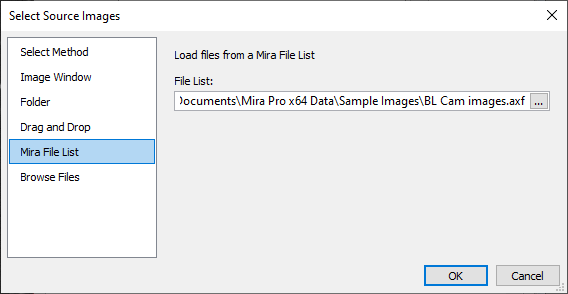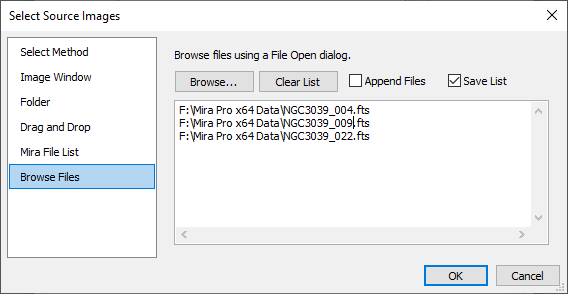|
|
Selecting Source Images NOTE: This topic applies only to
global processing commands provided in the menus opened
using the Source images for global processing commands are the "input" images used by a parent command, such as images being rotated by Rotate Images or calibrated using Express Image Calibration. This topic describes the options for source image selection provided through the Select Source Images dialog. This dialog does not actually collect the images but sets the properties used for subsequent image collection by the parent command. Each parent command has an independent set of image selection properties. For collecting source images, Mira commands use a common interface, the Source Images Control Group shown below. This group accesses the Select Source Images dialog for configuring how the command will collect its source images. This group is shown below as it appears on a generic command dialog. Use the [Select] button to open the Select Source Images dialog for setting source image selection properties. Later, when the command is executed, images are collected and processed according to the properties configured in the Select Source Images dialog. Here is the Source Images Control Group appearing in the command dialog:
The Select Source Images dialog includes 6 pages: the Select Method page for choosing the source image selection method, and 5 pages for configuring each of the selection methods. Commands remember their source image selection properties, and these properties are initialized the next time Select Source Images is used by the command.
Specifying the Source ImagesSpecifying how source images are collected is a two-step process. Usually, it is not necessary to complete both steps each time for a given command as the parameters are saved specifically for the command (for example, source image properties for Image Arithmetic and Rotate Image are saved independently). The properties for a given command do not usually need changing unless the image selection is volatile by using different file names, a different folder, different image window, and so on. The source selection properties are configured in a two-step process using the pages listed in the left panel of the Select Source Images dialog. The top page, named Select Method..., is used to choose the source, while the 5 pages underneath are used to configure the source. This two-step process is outlined below. The order they are completed is not important:
Each of the 6 pages in the Select Source Images dialog is described below. Select Method... PageThe Select Method... page shows a bullet list of pages with options for selecting images. The selected (bulleted) method is passed back to the parent dialog using the properties configured on the specific method page. The method pages are configured by selecting them from the list in the left panel of the dialog. Click the name to configure the properties of the selected method. For example, the picture below shows the "Folder" method selected as the target method. To configure the Folder method,. click its name in the left panel and set its properties as desired.
Image Window PageThe Image Window page selects images displayed in an Image Window. The list box contains the name of the current image for each Image Window on the Mira desktop. The window list is created when this dialog is opened, and it will be empty if no Image Windows are open. If selecting images from an Image Window, it is often simpler to use the "immediate mode" version of the command from the Image Window menu (see Command Dialogs).
Folder PageThe Folder page selects images from files in a folder. Optionally, several file selection rules may be used to filter which images will be selected from the folder. If no rules are used, then all files in the folder will be selected. This page remembers its settings between sessions, however it is possible that the listed folder may not exist in a new session.
Drag and Drop PageThe Drag and Drop page provides a "hot" target area where files can be dropped using the Windows drag & drop technique. Files are selected by marking them in Windows Explorer (the file manager), then dragged onto the target area.
Mira File List PageThe Mira File List page is used for
selecting a
Mira File List containing the selected files. The
Mira File List is a single text file containing the full path
specification for 1 or more files. File lists have a
Browse Files PageThe Browser Files page opens a Windows Open dialog for selecting files. A powerful feature of this page is the Append Files option. This causes new files to be added to the list of files already in the box. The [Browse...] button activates the standard Windows Open dialog for selecting files. A limitation of the Open dialog is that it can only select files from a single folder at one time. Checking Append Files allows you to browse different folders, each time adding files from a new folder to the growing list.
Related Topics
Mira Pro x64 User's Guide, Copyright Ⓒ 2023 Mirametrics, Inc. All
Rights Reserved. |



